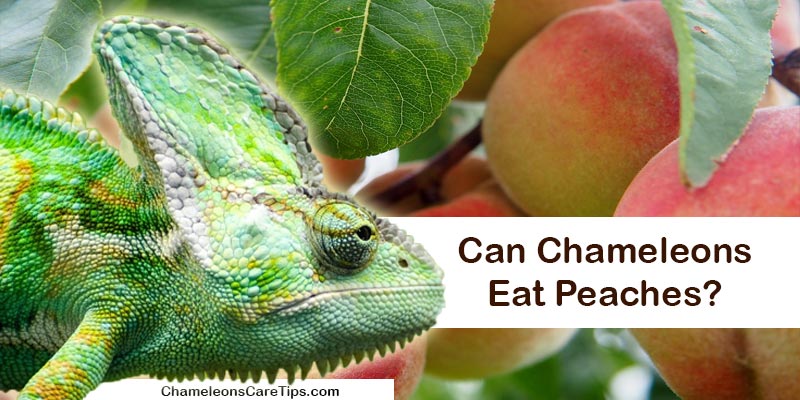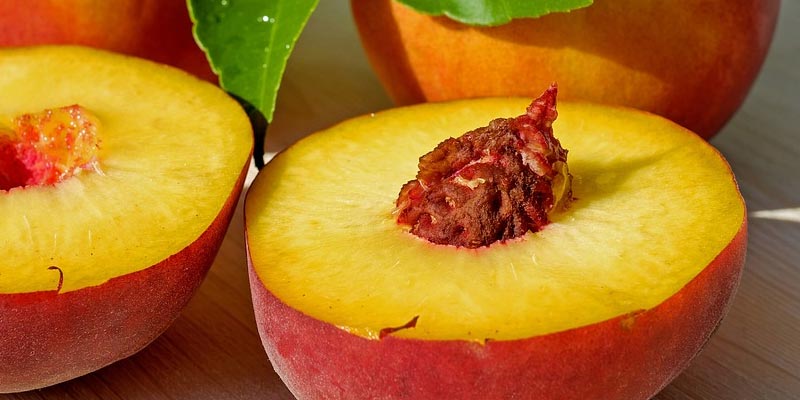Known for their unique ability to change color and diverse dietary preferences, chameleons fascinate us. Although they primarily feast on insects, we must ask: is it possible for a chameleon to indulge in peaches?
This article delves into the suitability of this juicy fruit for chameleons; and explores potential risks and benefits associated with feeding them such an exotic treat – providing guidelines along the way.
Table of Contents
Can Chameleons Consume Peaches?
Generally, chameleons feast primarily on insects as they are insectivores; however, in the wild – albeit infrequently – they might indulge in a bit of fruit. You can offer captive chameleons the delicious and nutritious treat of peaches. Peaches, with their high water content and natural sugars, offer reptiles a source of hydration and an immediate energy boost.
Does Feeding Peaches To Chameleons Pose Any Risks?
Peaches, a potentially tasty addition to a chameleon’s diet, pose significant risks one must acknowledge that the high sugar content in fruits may induce obesity and metabolic issues if over-consumed by these creatures.
Furthermore, because chameleons might not readily recognize fruits as food—introducing them gradually and in small amounts becomes crucial for monitoring their response.
Benefits Of Peaches For Chameleons
Incorporating peaches into a chameleon’s diet, when done in moderation, offers several benefits: their juicy and sweet flesh provides an array of nutrients that contribute to the overall health of these primarily insectivorous creatures.
While chameleons primarily consume insects; adding fruits such as peaches can broaden their nutritional intake–thus enhancing their general well-being. Feeding chameleons with peaches yields the following advantages:
1. Hydration: With their high water content, peaches provide chameleons excellent hydration; this is crucial for the health of their organs, skin, indeed overall well-being. Maintaining adequate humidity levels in captivity can pose a challenge. However, offering water-rich fruits such as peaches aids in maintaining optimal hydration for chameleons.
2. Vitamins: Essential vitamins, notably vitamins A and C, are present in peaches; the former plays a critical role in maintaining healthy skin, alongside mucous membranes and vision. Captive chameleons might not invariably acquire adequate amounts of necessary Vitamin A from their insect-only diet: thus rendering peaches as an invaluable supplement. The immune system is supported by Vitamin C, an antioxidant that bolsters overall health.
3. Antioxidants: Peaches contain antioxidants that actively neutralize free radicals in the chameleon’s body, thereby mitigating potential oxidative stress. Since free radicals can induce cell damage, these potent effects of antioxidant-rich diets play a crucial role in overall health and longevity for chameleons. Therefore: incorporating peaches into their diet would significantly boost your pet’s welfare over time – an investment worth considering!
4. Boost of Energy: Peaches’ natural sugars offer chameleons a swift energy boost; although their primary protein source consists of an insect diet, the fruit sugars present an expedited energy supply, particularly beneficial during heightened activity periods.
5. Dietary Variety: Chameleon health necessitates the provision of a diverse diet. Although insects serve as its primary food source, introducing fruits such as peaches not only adds variety but also potentially piques the chameleon’s interest in food. This diversification yields nutritional benefits and enhances overall well-being by providing mental stimulation for the chameleon.
Are Peaches Suitable for Baby Chameleons to Consume?
The rapid growth and development of baby chameleons necessitate a primarily insect-based diet such as crickets and Dubia roaches; therefore, it is recommended. Although an occasional offering of small amounts of fruits such as peaches may be acceptable, the emphasis must remain on providing them with a balanced, nutritionally dense diet that caters to their specific needs.
Do Peach Seeds Serve As a Viable Dietary Option For Chameleons?
Before offering the fruit to chameleons, one must crucially remove the peach pit or seed; these seeds contain compounds such as amygdalin, which is a substance that can release cyanide upon decomposition.
Cyanide is known for its toxicity and potential harm to chameleons. Underscores here an urgent need for preventive measures. Before offering the peach to your chameleon, ensure it is pitted and cut into small, manageable pieces.
Peach Feeding Methods for Chameleons
When you introduce peaches to a chameleon’s diet, it becomes essential to take their feeding habits into consideration: Chameleons may not readily accept fruits.
Attempt offering them small, bite-sized pieces directly on a plate or from your hand; you might also consider mixing peach slices with their regular insect diet, which is an approach that could encourage acceptance.
Engage in experimental trials, testing a variety of methods; ultimately, identify the approach that best suits your chameleon.
How Frequently May Chameleons Consume Peaches?
One should feed peaches to chameleons in moderation: as a treat, offer them once or twice weekly depending on the tolerance and response of each individual chameleon. Always be vigilant for any signs your pet may exhibit—digestive issues or aversion to the fruit.
Conclusion
Concluding, if you offer peaches to your chameleon in moderation, they may find them a delightful addition to their diet. This fruit not only imparts essential vitamins and hydration but also carries potential risks such as high sugar content and pit presence; therefore, exercise mindfulness.
Ensure a healthy and well-balanced diet for your chameleon by introducing peaches gradually while observing its response diligently. Consulting with a veterinarian knowledgeable about reptile care is advisable as this action ensures your chameleon’s well-being – an essential consideration when implementing any dietary changes.


